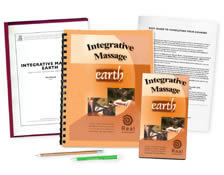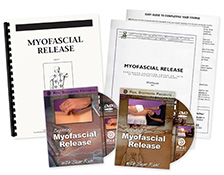

 Want to earn continuing education credit for this article? Learn more.
Want to earn continuing education credit for this article? Learn more.
Whether due to its inherently gentle nature or its ability to correct an array of common childhood misalignments, myofascial release is an ideal technique to incorporate into pediatric bodywork.
About Myofascial Release
Myofascial release originated in osteopathic medicine and has since spread into physical and massage therapy. The fascia can be viewed as a continuous formation based on understanding the body’s connective tissue as a densely woven, three-dimensional covering that joins all of the body’s structures together.
Healthy fascia is relaxed and wavy, stretching and moving without restriction. However, the fascia loses its flexibility with physical trauma, scarring, or localized tissue inflammation. In addition, due to being tightened and thus restricted, fascial injury creates tension for the rest of the body. Myofascial release has helped countless recipients find pain relief and restored range of motion by applying sustained pressure to myofascial restrictions.
John F. Barnes, PT, described progressively stretching the fascia until deeper layers of fascial restriction can be accessed in his Pediatric Myofascial Release Seminar Workbook. Barnes explains that releasing fascial restrictions is accomplished by stretching the fascia’s elastic and linking components to change its viscosity.
Myofascial Release for Children
When babies or older kids have chronic pain, illness, or any noticeable dysfunction, advocates of myofascial release believe that fascial restriction may be a contributing factor. Effective myofascial release sessions have been reported for children with the following issues:
- Scoliosis or other postural anomalies
- Birthing injuries
- Head trauma
- Cerebral palsy
- Neurological conditions
- Movement disorders
- Chronic respiratory disease
This technique is especially valuable when working with the pediatric population because fascial restrictions often result from the fetus’ position in utero and are present at birth. Most healthy children appear to outgrow fascial restriction causing deformities as they become increasingly mobile. However, fascial shortening may profoundly impact movement and posture and could remain for life.
So Gentle
In general, myofascial release is well-suited for children because tissues are not manipulated forcefully. Instead, fascial restrictions are gently held at their barrier for as long as it takes to release. Barnes describes myofascial release in a step-by-step approach:
- With relaxed hands, slowly stretch out the elastic component of the fascia until you reach a barrier.
- Maintain sufficient pressure to hold the stretch at the barrier and wait a minimum of 90 to 120 seconds, usually longer.
- Do not try to force through the barrier.
- Before the release, you may perceive a heat buildup, a throbbing or fluttering sensation.
- As the restriction barrier recedes, the practitioner feels motion and softening under their hands.
- Continue the pressure as long as the motion persists.
- Be gentle.
- Do not try to force or aim the movement in any way.
- Merely engage the barrier, wait and go with it wherever it takes you.
Specific Examples
Although there are a wide range of applications for myofascial release in children, below are three examples of when this modality is warranted:
- Sternocleidomastoid – Releasing a shortened sternocleidomastoid may relieve local discomfort and pain, improve the head’s posture, promote cervical spine mobility and support cranial bone growth. Restriction of the sternocleidomastoid can easily result from a twisted neck in utero.
- Diaphragm – Releasing the fascia surrounding the diaphragm can help ease difficult respiration and chronic hiccups while improving oxygenation of the blood supply. Tightening caused by a baby’s rotational twist in the birth canal could create diaphragmatic fascial restriction.
- Growing Pains – Typically occurring in kids between the ages of three and six, growing pains in the lower legs usually occurring at night after strenuous activity. The cause is believed to be fascial strain due to rapid growth. The fascial tension can be effectively relieved by stretching and releasing restrictions in the sacrum and the lower extremities.
A bodyworker needs training in myofascial release, understanding childhood fascial restrictions, a gentle touch, and patience to apply this modality to the pediatric population. Whether working with an infant, pre-schooler, or teenager, myofascial release can correct troubling body dynamics stemming from tightened, inflexible fascia.
Earn continuing education credit for this article contained in our Prenatal & Pediatric Massage series. Click here to enroll.













